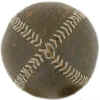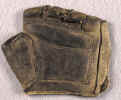|
In the early days of baseball the first players to use gloves were often taunted and teased as being "too soft" or "sissies" because they did not want to catch the ball with their bare hands. It was considered unmanly. It wasn't until 1907 before catchers shin guards were used. The first baseballs were hand stitched, and I would find it hard to believe that even today's ballplayers could hit one out of the park.
At one time baseball bats were allowed to be flat on one side. Collecting vintage baseball equipment is an education of the evolution, and
innovations that led to the high tech game of today.
 The 4 piece hand stitched leather skinned baseball was one of the first style baseball used. They are
referred to today as the
"Lemon Peal" style
baseball. Dark leather was used for the cover because it was readily available and easier for the players to see when the ball was hit in the air on a clear day. White baseballs were later introduced (1861) because most ball fields at the time had heavily wooded area back drops, and it was easier to see the white ball. The 4 piece hand stitched leather skinned baseball was one of the first style baseball used. They are
referred to today as the
"Lemon Peal" style
baseball. Dark leather was used for the cover because it was readily available and easier for the players to see when the ball was hit in the air on a clear day. White baseballs were later introduced (1861) because most ball fields at the time had heavily wooded area back drops, and it was easier to see the white ball.
Interesting to note that in the early 1970s Oakland Athletics owner Charlie Finley tried to introduce a bright
Orange Baseball. The Orange Baseball had two principal advantages over conventional white baseballs: (1) fans could follow the flight of an orange ball more easily than a white ball, especially when hit to the outfield, and (2) the batter could more easily see an orange ball being delivered at a speed of 90-100 miles per hour out of the normally white background of a pitcher's uniform.
In exhibition games where the ball was used, fans reacted in an overwhelmingly positive manner to the Orange Baseball. Umpires also attested to the benefits of the Orange Baseball, stating that the ball was not only easier to see from behind the plate, but gave rise to a greater number of hits and fewer fielding errors. The Idea was never picked up by major league baseball. manner to the Orange Baseball. Umpires also attested to the benefits of the Orange Baseball, stating that the ball was not only easier to see from behind the plate, but gave rise to a greater number of hits and fewer fielding errors. The Idea was never picked up by major league baseball.
First introduced in the 1840s The tightly stitched professionally manufactured Figure-eight Baseballs were not used until the 1870s.
"Figure 8" stitched baseballs are similar to the baseball used today. In 1859 the rules stated that a ball must weigh 5.75 to 6 ounces and measure 9.75 to 10 inches in circumference.
Today's baseballs are 9 inches in circumference, 5 ounces, and 108 stitches.
Hall of Fame Catcher Roger Bresnahan Played between 1897 - 1915 Bresnahan most notable contributions to the game were in protective equipment. In 1905 after getting "beaned" in the head with a baseball began experimenting with head gear similar to the leather football helmet of the period that were made by A.J. Reach. Sliced vertically: one half for covering the left side of a right handed batter's head, the other for the lefty hitter.
 Two years later in 1907 he devised Catcher's
Shin Guards. The first, evidently modeled after a cricketer's leg pads but were large, and bulky. NL president Pulliam dismisses the opening day protests of Pittsburgh manager Fred Clarke over Roger Bresnahan's shin guards. As yet, Bresnahan was the only catcher using them. Ignoring the ridicule, it was not thought to be gentlemanly to use them. By 1909 the design was refined, and became accepted, and more wildly used.
Two years later in 1907 he devised Catcher's
Shin Guards. The first, evidently modeled after a cricketer's leg pads but were large, and bulky. NL president Pulliam dismisses the opening day protests of Pittsburgh manager Fred Clarke over Roger Bresnahan's shin guards. As yet, Bresnahan was the only catcher using them. Ignoring the ridicule, it was not thought to be gentlemanly to use them. By 1909 the design was refined, and became accepted, and more wildly used.
The first baseball gloves were used in the 1870s. The basic idea was to create a glove that would pad and protect the players' hands and provide a cushion for catching the ball. Surprisingly, the first gloves were designed so the player could knock the ball to the ground and not necessarily catch it. History's first baseball gloves were made from pieces of leather sewn together to fit over a player's hand. Many early baseball gloves were simple leather gloves with the
fingertips cut
off, supposedly to allow for the same control of a bare hand, but with extra padding. The adoption of the baseball glove by baseball star Albert Spalding when he began playing first base influenced more infielders to begin using gloves. By the mid 1890s, it was the norm for players to wear gloves in the field. ground and not necessarily catch it. History's first baseball gloves were made from pieces of leather sewn together to fit over a player's hand. Many early baseball gloves were simple leather gloves with the
fingertips cut
off, supposedly to allow for the same control of a bare hand, but with extra padding. The adoption of the baseball glove by baseball star Albert Spalding when he began playing first base influenced more infielders to begin using gloves. By the mid 1890s, it was the norm for players to wear gloves in the field.
19th century bats were generally heavier and considerably thicker in the handle and had more of a gradual taper from the handle to the barrel about" 3 feet
long, round, tapered and was to be between an inch and a half at the
handle to three inches at the barrel. In 1857, the dimensions agreed upon were described as round, not to be more than two and one-half inches around in its thickest part and was to be no longer than 42 inches.

1920’s Ty Cobb Louisville Slugger Baseball Bat
The National League made two major changes for 1885. It was now legal to have 18 inches of the handle wrapped in twine and one side of the bat was allowed to be flat. The American Association adopted this rule when they followed the same rules as the National League in 1887. In 1893, the bat was no longer allowed to be flat on one side but was required to be round. The length was still limited to 42 inches and the thickness of the thickest part was still two and on-half inches. The thickness of the bat was increased to two and three-quarters inches in 1895 and remains the same today.
Collecting
vintage baseball equipment can bring back the thrill of owning the bats,
and gloves we used as kids, endorsed by our favorite player. A
documentation of the evolution of the tools used to play the game over
the years.
More links to vintage baseball
Equipment
Vintage Baseball Glove Dating Guide
Find information on what year your vintage baseball glove was made. follow the evolution of baseball gloves.
Date
and Price your Vintage Baseballs
Find information on
what era your official baseball is from, and its estimated value.
Equipment
Find information on
vintage baseball equipment from shin guards, and bases to Stadium seats
SEND FEEDBACK TO:: Steve@KeyManCollectibles.com
KeyManCollectibles
Newsletter #1 What It Worth?
KeyManCollectibles Newsletter #2 Road
Trip Fenway Park
KeyManCollectibles Newsletter #3 Fake
Similar Autographs Facsimile
KeyManCollectibles Newsletter
#4 Collecting Vintage Baseball Memorabilia Advertising
|
|
|
HomeRunMonkey.com
stocks the best catchers gear designed to help catchers of all ability and ages improve their work behind the plate. Featuring catcher's gear with latest advances in performance and technology to keep a catcher safe while performing at peak performance levels. Masks, helmets, chest protectors,
mitts, throat protector, knee savers, leg guardsand catcher gear bags from top makers like Wilson, Easton Rawlings, Mizuno, Diamond, Louisville Slugger, Worth, Farrell and Reebok. |
|
